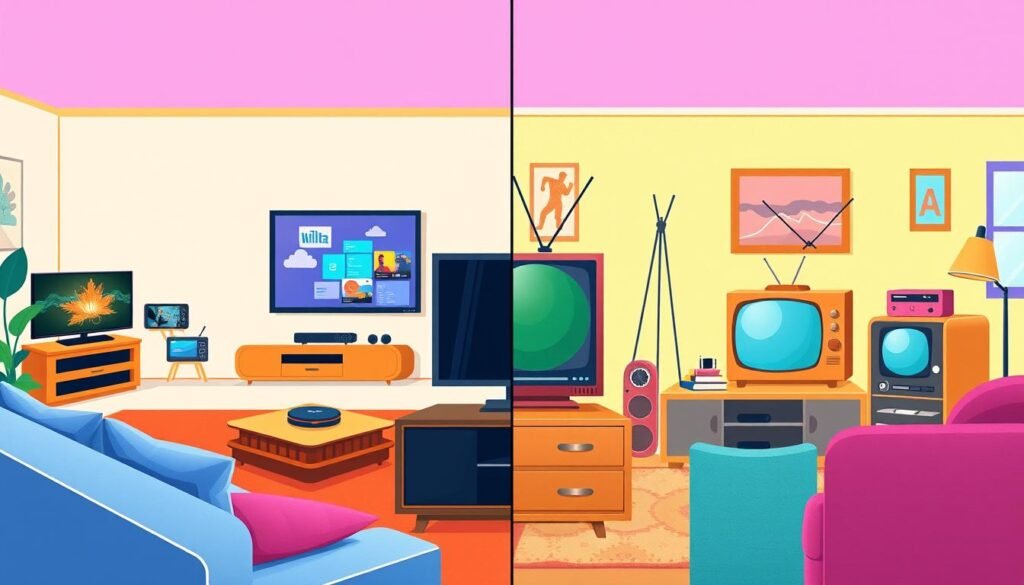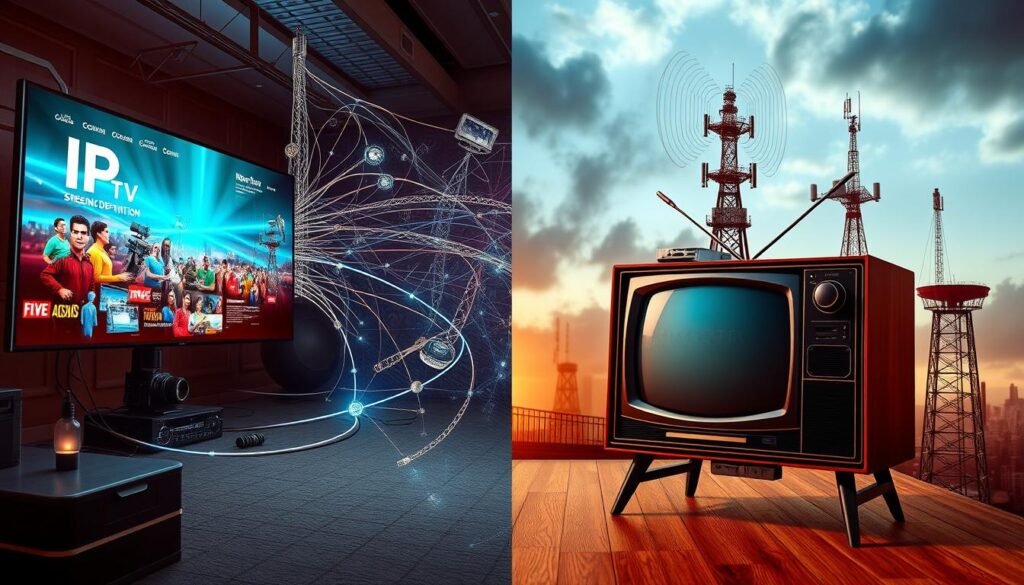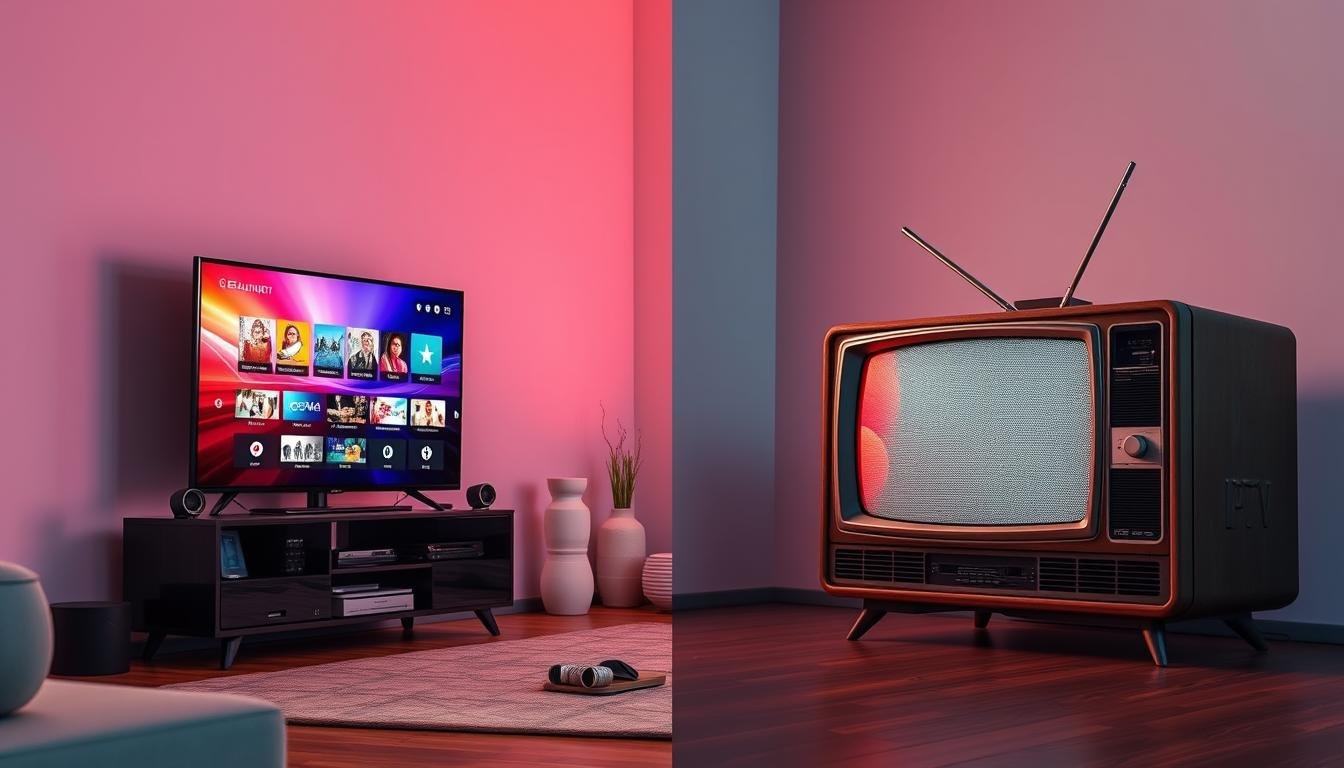In the UK’s media world, Internet Protocol Television (IPTV) is changing things. It’s making traditional TV less popular. People love IPTV for its ease and flexibility, wondering if it’s making old TV less valuable.
IPTV has brought a new way to watch TV, using the internet. Now, viewers can watch lots of shows on their devices. This change has made traditional TV less appealing. The COVID-19 pandemic has made people watch more online, making IPTV even more popular.
Key Takeaways
- IPTV subscriptions are challenging the dominance of traditional broadcasting in the UK market.
- Streaming services offer consumers greater convenience and flexibility, leading to a decline in traditional TV viewership.
- The COVID-19 pandemic has further accelerated the shift towards IPTV, as lockdowns and social distancing measures have driven increased reliance on streaming.
- The impact of IPTV subscriptions on traditional broadcasting’s revenue and advertising models is a topic of growing concern.
- The future of media consumption in the UK will likely involve a dynamic interplay between IPTV and traditional broadcasting, as both sectors adapt to the changing industry landscape.
Understanding IPTV: A Modern Alternative to Traditional TV
How IPTV Subscriptions Devalue Traditional Broadcasting? In today’s digital world, Over-the-Top (OTT) Media Services are changing how we watch TV. Internet Protocol Television (IPTV) is a big hit, offering a new way to watch live and on-demand shows. It lets viewers pick what they want to watch, making it easy and fun.
What is IPTV?
IPTV uses the internet to send TV shows to your devices. It lets you watch lots of channels and on-demand shows online. Unlike old TV, IPTV uses the internet to send shows, giving you a better viewing experience.
How IPTV Works
IPTV sends TV signals over the internet, not through old TV ways. You can watch IPTV on many devices, like smart TVs and phones. This means you can watch your favourite shows anywhere, anytime.
Key Benefits of IPTV
IPTV has many good points that make it better than old TV:
- Diverse content options: IPTV has lots of channels and shows, for all kinds of interests.
- Flexible viewing experience: You can pause, rewind, and record live TV. You can also watch shows when you want, giving you control.
- Enhanced user experience: IPTV has easy-to-use interfaces and cool features, like recommendations and watching on different devices.
- Cost-effectiveness: IPTV is cheaper than old TV, making great shows more affordable.
As more people want OTT Media Services and Streaming Video on Demand, IPTV is becoming more popular. It’s a modern, easy, and affordable way to watch TV.
“IPTV is the future of home entertainment, offering a personalised and on-demand viewing experience that traditional TV simply cannot match.”
The Rise of IPTV in the UK
The UK has seen a big increase in Internet Protocol Television (IPTV) popularity. This is because people want more flexible and personal viewing. Also, high-speed broadband is now more common in the country.
Growing Popularity of Streaming Services
Services like Netflix, Amazon Prime Video, and Disney+ have become very popular. They offer lots of content and let viewers watch at their own pace. This has made many choose them over traditional TV.
Trends in IPTV Subscriptions
- Recent reports show IPTV subscriptions in the UK have risen by over 20% in two years. Now, 8.2 million households have subscriptions.
- Younger people, especially those aged 18-34, are leading this trend. A whopping 75% of them have at least one IPTV service.
- Meanwhile, traditional pay-TV subscriptions are falling. Over 1 million households have switched from satellite or cable TV in the last year.
Effects of Covid-19 on Viewing Habits
The Covid-19 pandemic has made IPTV and streaming services even more popular. People staying home more have boosted demand for on-demand content. This has led to a big rise in IPTV and subscription-based model use.
The growth of IPTV in the UK shows how the media world is changing. People are choosing the convenience and flexibility of cord-cutting and subscription models. This change is a big challenge for traditional broadcasters, who need to adapt quickly.
Comparing IPTV with Traditional Broadcasting
When we look at Internet Protocol Television (IPTV) and traditional broadcasting, we see big differences. These include content, pricing, and how users experience it. This comparison will help us understand how media is changing.
Content Availability and Options
IPTV has a huge range of content. You can find live channels, on-demand shows, and movies. It meets many viewer needs, letting them watch what they want when they want. Traditional Pay TV, however, has fewer choices. It’s limited by broadcast schedules and channel packages.
Pricing Models: IPTV vs Traditional TV
IPTV and traditional TV have different pricing. IPTV uses a Unicast Delivery model, where you pay for what you want. This is often cheaper than traditional TV. Traditional TV, however, requires you to buy bundles of channels, even if you don’t watch them all.
User Experience and Interface
IPTV has easy-to-use interfaces. It makes finding and watching content simple. It also offers features like personalised recommendations and pause/rewind live TV. Traditional TV, while reliable, is less interactive and offers fewer choices.
| Criteria | IPTV | Traditional Broadcasting |
|---|---|---|
| Content Availability | Extensive library, on-demand and live options | Limited to scheduled programming and channel packages |
| Pricing Model | Customisable, pay-per-service or package | Bundled channel packages |
| User Experience | Intuitive interface, personalised recommendations | Rigid, less interactive viewing experience |
IPTV gives a more flexible, personal, and affordable way to watch TV. Traditional TV is reliable but less interactive. As media changes, knowing these differences helps us choose how we want to watch.

Audience Demographics: Who’s Choosing IPTV?
The popularity of streaming services is growing in the UK. It’s important to know who is choosing IPTV. The move to on-demand content has changed what viewers want.
Age Groups and Viewing Preferences
Young people, aged 18 to 34, are leading in IPTV adoption. They like the flexibility and ease of IPTV. It lets them watch their favourite shows whenever they want.
Older viewers, especially those 55 and above, are slower to adopt IPTV. They prefer traditional TV and may find it hard to change.
Urban vs Rural Usage Patterns
IPTV use varies between cities and rural areas in the UK. City dwellers quickly adopted IPTV. They have fast internet and lots of content to choose from.
Rural areas face challenges with IPTV due to poor internet. This digital gap slows IPTV adoption there. It shows the need for better internet in rural areas.
“The future of media consumption lies in striking a balance between traditional broadcasting and the convenience of streaming services. As IPTV continues to evolve, it will be crucial to address the diverse needs and preferences of viewers across all age groups and geographic regions.”
The Impact on Advertising Revenue
Over-the-Top (OTT) media services like IPTV are becoming more popular. This change is affecting how ads are shown and sold. Traditional broadcasters are finding it hard to keep up with these new digital media trends.
How IPTV Changes the Advertising Landscape
IPTV offers interactive and customised content. This means ads can be more targeted and relevant. Advertisers can use detailed viewer data to create more effective ads. This leads to better engagement and more value for money.
Effect on Traditional Broadcasters’ Budgets
- More brands are spending on digital platforms and OTT services. This is because IPTV offers better targeting and measurement.
- Traditional broadcasters are facing tough competition for ad revenue. IPTV and streaming services can target audiences more precisely.
- To stay ahead, traditional broadcasters are trying new ad strategies. They’re looking into programmatic advertising and addressable TV.
| Metric | Traditional Broadcasting | Over-the-Top (OTT) Media Services |
|---|---|---|
| Audience Targeting | Broad demographic-based targeting | Highly personalised, data-driven targeting |
| Advertising Formats | Linear ad breaks | Interactive, non-linear ad formats |
| Measurement and Analytics | Limited data and metrics | Comprehensive, real-time data and analytics |
The media world is always changing. Traditional broadcasters and OTT providers must keep up with new ad strategies. This is key to staying relevant in the digital age.
Quality and Reliability: IPTV vs Traditional Broadcasting
The rise of Streaming Video on Demand (SVoD) and IPTV in the UK has raised concerns about quality and reliability. Traditional broadcasting has always been the top choice for video quality. But IPTV brings new challenges, like streaming quality and internet connection issues.
Streaming Quality
IPTV can deliver high-definition (HD) content straight to your device. But, the quality depends on internet speeds and compression algorithms. This can cause lags, pixelation, or interruptions, especially when many people are online.
Issues with Internet Connectivity
IPTV relies on a good internet connection, unlike traditional broadcasting. Problems like network congestion or ISP outages can affect IPTV. This leads to buffering, connection drops, or poor image quality.
| Feature | IPTV | Traditional Broadcasting |
|---|---|---|
| Streaming Quality | Dependent on internet speed and compression algorithms | Consistent high-quality video delivery |
| Reliability | Vulnerable to internet connectivity issues | Dedicated and reliable infrastructure |
IPTV providers are working hard to improve their services. They’re investing in better infrastructure and streaming algorithms. They’re also teaming up with internet service providers to offer a more reliable experience. As technology advances, IPTV quality and reliability will likely get closer to traditional broadcasting.

Regulation and Legal Considerations
The UK’s IPTV market is growing fast, but it faces many rules. IPTV providers must deal with licensing and follow broadcast standards. These rules affect how they offer their services.
Licensing Concerns with IPTV
IPTV is different from traditional TV in legal terms. Providers need content licences and must follow agreements. Getting these can be slow and expensive.
This makes it hard for new IPTV companies to start. It might also reduce choices for viewers.
Compliance with UK Broadcast Standards
IPTV in the UK must follow Ofcom’s rules. This includes guidelines on ads, accessibility, and content. Not following these can lead to big fines or even losing a licence.
The rules for IPTV are changing all the time. Experts say this creates uncertainty for providers and viewers. A strong, flexible set of rules is needed to keep things fair and protect everyone’s interests in the UK.
Future Trends in Broadcasting
The media world is changing fast, bringing new chances for broadcasting. Hybrid Broadcast Broadband TV (HBB TV) is becoming more important. It mixes old TV with internet content, giving viewers more choices and a better experience.
Predictions for IPTV Growth
IPTV, or subscription-based TV, is set to grow a lot. People like watching what they want, when they want. So, IPTV subscriptions are likely to keep going up. Experts think IPTV will take a bigger part of the market, making traditional TV less dominant.
How Traditional TV Can Adapt
Traditional TV needs to change to stay ahead. It might use HBB TV, give more tailored content, and try new ways to get viewers. By mixing old TV with new streaming, it can stay relevant in a changing world.
“The future of broadcasting lies in the harmonious integration of traditional and digital platforms, empowering viewers with unparalleled choice and control over their media consumption.”
Conclusion: The Future of Media Consumption
The media world is changing fast, with IPTV and traditional TV in the UK facing a complex mix of challenges and opportunities. While IPTV subscriptions have shaken up the old TV ways, it’s too early to say traditional TV is doomed.
Is Traditional Broadcasting at Risk?
Streaming services and IPTV have shaken the old TV’s grip. Younger viewers are drawn to on-demand, custom content, which IPTV and OTT do well. Yet, traditional TV has shown it can adapt, changing its ways to keep up with viewer tastes.
Harmonising IPTV and Traditional Broadcasting
The UK’s media future likely sees IPTV and traditional TV working together. As internet speeds get better and IPTV tech improves, old TV will need to join the new wave. This might mean offering IPTV services, teaming up with streaming giants, or coming up with fresh content and ways to share it.
In the end, the UK’s media scene will be shaped by how well IPTV and traditional TV can change, innovate, and offer content that speaks to everyone. As things keep moving, finding a balance between IPTV’s ease and traditional TV’s charm will be key.

